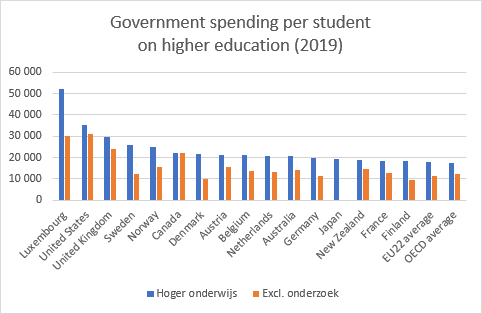In the top ten
Netherlands among countries that invest the most in higher education

On Monday, the Organisation for Economic Cooperation and Development (OECD) published its annual report Education at a Glance, this time with a special focus on higher education. According to the document, the sector needs to adapt now that so many young people are entering higher education.
The number of students is continuing to rise in all 38 member countries. In 2000, only 27 percent of 24 to 34-year-olds had a degree from a university or a university of applied sciences in the Netherlands, compared to 48 percent in 2021. Higher education institutions must therefore cater to an increasingly diverse group of students.
A higher education degree seems to have become the new norm everywhere, and this is having an adverse effect on vocational education. The report argues that some students would actually be better suited to vocational education, but they will only take this path if vocational programmes are made more attractive, not least by strengthening links with higher education. These students should also be given the opportunity to continue their studies later on in life.
Investment
The report also contains many comparisons that shed light on the different choices made by the member countries, such as how much a country is willing to spend on higher education and research. The Netherlands is among the top ten, spending more money than average.
“However, we are not in the top five and that does not reflect our ambitions,” writes the current Minister of Education, Robbert Dijkgraaf, alongside the former Minister of Education Dennis Wiersma in response to the OECD report. They expect the additional investments recently announced by the Dutch government to remedy the situation.

Source: Education at a Glance, OECD. These are the countries whose investments in higher education are above average.
Dijkgraaf explained that the additional spending is necessary to ensure that the ever-growing number of students does not have a negative impact on Dutch higher education. The minister also reiterated that he will look for “new instruments to control student flow” in response to the significant number of international students coming to the Netherlands.
Stress
The Dutch government is also reintroducing the basic student grant, albeit in a new form. Given the high number of Dutch students now working alongside their studies, there appears to be a real need for this change: 47 percent of students have part-time jobs, compared to the average of 17 percent for other OECD countries. In addition, a relatively large number of students are taking longer to complete their education, although most of them do graduate eventually. The ministry is taking these findings on board in a new study on the pressure to perform and stress among students.
The workload of the teaching staff is also relatively high in the Netherlands. On average, a lecturer teaches 15 students, which puts the Netherlands a little above the OECD average. On the other hand, the workforce in the higher education sector is relatively young.

Source: Education at a Glance 2022. Countries above average. Data from 2019.
Deficit sectors
The OECD also analysed what is happening in the labour market and discovered that Dutch graduates are well placed when it comes to finding a job. Of those with a higher education degree, 91 percent are employed, which is well above the OECD average of 85 percent.
The Netherlands does, however, have some persistent "deficit sectors": only 12 percent of students pursue a STEM degree, compared to 16 percent on average in OECD countries.